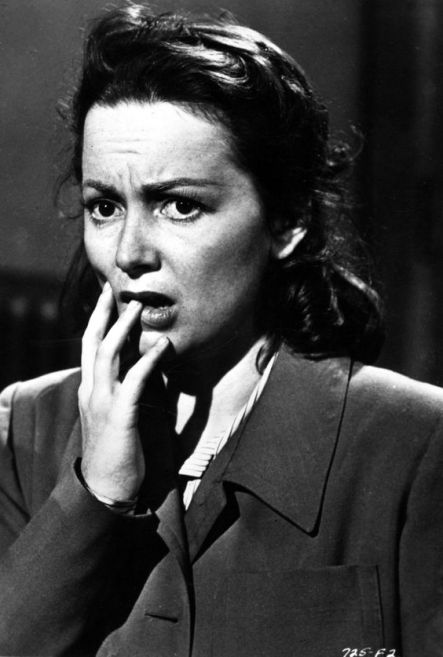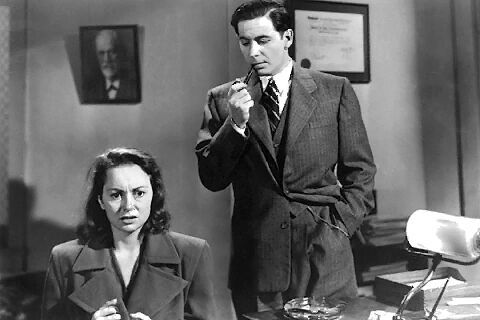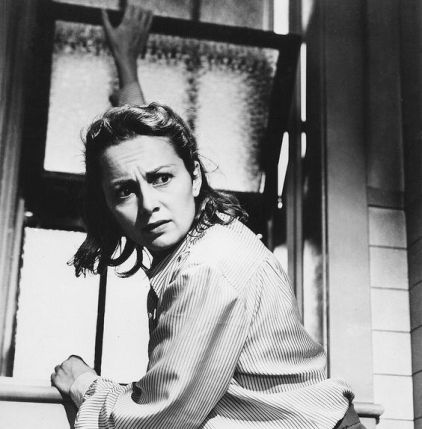
Today, the legendary Olivia de Havilland is turning 102 years old! What a victory! For a third consecutive year, Crystal from In the Good Old Days of Classic Hollywood and Laura from Phyllis Loves Classic Movies are hosting the Annual Olivia de Havilland Blogathon. I’m happy to take part in the celebrations with an article about The Snake Pit, a movie based on the successful novel by Mary Jane Ward. Last year for the blogathon, I presented a top 10 of my most favourite Olivia de Havilland’s films and ranked this one #3 behind Gone With the Wind and The Heiress.

The following article will mostly focus on Olivia de Havilland’s performance.
***
The Snake Pit is a 1948’s psychological drama directed by Anatol Litvak. The cast includes Olivia de Havilland, Mark Stevens, Leo Genn, Celest Holm, Ruth Donnelly, Beulah, Betsy Blair, and more. The story revolves around Virginia Cunningham (Olivia d Havilland), a woman who has been admitted to a mental institute after a nervous breakdown. Not “herself” anymore, she will receive the help of Dr. Kik (Leo Genn) to get better and understand the origin of her mental condition.

***
In the late 40s and 50s, more and more Hollywood movies depicting mental health were being made. If Spellbound (Alfred Hitchcock, 1945) was the first movie about psychoanalysis, it reminded quite “innocent” in comparison to The Snake Pit. Litvak’s film indeed presents more shocking scenes. It might not be a film about psychoanalysis as much as Spellbound is, but the general theme remains the same: trying to understand the psychological state of a person.

Olivia de Havilland received an Oscar nomination for her troubling portrayal of Virginia Cunningham. This was not the first time she was playing a character suffering from mental illness: The Dark Mirror (Robert Siodmak) was released two years prior. Movie director Anatol Litvak insisted on the actors (and the crew!) to visit mental institutions and such in order to prepare their roles and certainly give a realism to their delicate portrayals of patients, doctors or relatives. Olivia de Havilland took the task seriously and visited hospitals, assisted to electroshock therapy and to social events organized by the institutions. Her serious researches were successful as it helped her to develop a complex character. Playing such roles is not only about doing mimics to look “crazy”. It’s also about understanding what you are doing in order to do it correctly and not fall into the trap of ridicule.

Olivia de Havilland’s acting is done in a perfect way to make the spectator understand the evolution of her character. [SPOILER] Virginia does get better but this can’t be shown too “suddenly”. [END OF SPOILER] So, the actress adds a dose of serenity, a dose of confusion or a dose of sadness and solitude depending on the situation her character is facing. She chooses the right one so her acting remains natural and realistic. It’s almost like a recipe! There’s this scene at the beginning of the film where Virginia is introduced to us. She sits on a bench outside and smiles at the view of the singing birds. However, her apparent state of serenity doesn’t last long and a cloud quickly veils her face. Do you sometimes feel this way? You’re happy and suddenly you think about all the wrong things in your life and you are abruptly brought back to reality? The difference with Virginia is that she isn’t brought back to reality but to her “parallel” world created by her mental condition. This scene lasts only a brief moment but is well-done enough to make us feel this state of euphoria vanishing suddenly. Great job Livie!

The electro-shock scene is quite shocking (!), maybe not as much as the one in One Flew Over the Cuckoo’s Nest (Milos Forman, 1974) as it is not as explicit but, for a film made in the 40s, it probably wasn’t something people back then were used to see. What is disturbing isn’t only the archaicity of the electroshock themselves but also to see Olivia de Havilland in such a vulnerable position. Of course, it’s only acting and she didn’t really receive electro-shock treatments (!) but, in this scene, we completely forget about the actress and really think of her as a patient. This is the same as we are viewing her crisis scenes; in the flashback when she has her nervous breakdown in presence of her husband (Mark Stevens) or in this scene where she hides in a bathroom and is then trapped in a straitjacket by the nurses. Once again, this movie doesn’t really give a “beautiful” role to the nurses, who always seem to be rude to the patients. Well, they aren’t as bad as Nurse Ratched (Louise Fletcher) in One Flew Over the Cuckoo’s Nest, but they still play the type of people we prefer to avoid. Dr. Kik is, however, a man with a lot of compassion and we’re happy he’s here to establish a balance!

The Snake Pit probably was a psychologically challenging role (that’s why it was important to be well-prepared), but it also involved a certain physical challenge. Indeed, Olivia de Havilland had to lose weight in order to look like a sick woman. The actors don’t seem to wear any make up either or, if they do, it’s used to make them look sick, not glamorous. Moreover, Anatol Litvak insisted they didn’t show up at the hairdressing department.

***
On its release in 1948, The Snake Pit was generally well-received an even created a certain impact on the medicinal world. If psychiatrist Herman F. Weinberg questioned the way the subject was treated in the film, it, however, led the mental institutions in the United States to change their conditions. I think this is a perfect example of how important cinema is, and not only for the Arts but for every aspect of our society.
Is everything 100% realistic in this film? It remains a movie, and I’m not specialist enough on psychiatry to judge that, but I think the movie team did their best to make it as believable as possible. Anyway, if one their desires was to make us experience what Virginia Cunningham was feeling, it worked well. On its side, the “why” aspect of the film, embodied by Dr. Kik, sparks our curiosity and also makes us see things in an objective point of view. I personally have always liked films like taking place in mental institutions or that just include characters with an unstable psychological situation because they are so interesting! The mind is a complex thing and they are various ways to approach it. If cinema can be one of them, well goo. Not everybody is a psychiatrist, but everybody likes to have explanations.

Of course, in another article, we could explore the more technical aspects of the film, but, today, I preferred to focus uniquely on Olivia de Havilland!
With her portrayal of a complex character, the actress proved us that she had a great strength of character and that’s probably why she is still with us today! At 102, I wonder how she looks back at these days when she was shooting the film and if she is proud of herself. Because she should be!
***
Thanks to Crystal and Laura for hosting The Third Annual Olivia de Havilland Blogathon! Once again, the lady is a fascinating subject to write about.
I invite you to check the other entries here.
Happy 102 Livie!

Sources:
Doll, Susan. ” The Snake Pit.” Turner Classic Movies, nd. http://www.tcm.com/this-month/article/276838%7C0/The-Snake-Pit.html. Consulted on Jun 28, 2018.
“The Snake Pit, Trivia.” IMDB, nd. https://www.imdb.com/title/tt0040806/trivia?ref_=tt_trv_trv. Consulted on Jun 28, 2018.
“The Snake Pit.” Wikipedia. 13 Jun 2018. https://en.wikipedia.org/wiki/The_Snake_Pit. Consulted on Jun 28, 2018.


This is such a powerful film to watch. It makes for difficult watching because of how the patients were treated then. It is an important film for the reasons you mention. I think this is Olivia’s best screen performance.
LikeLiked by 1 person
I think I agree with you! Well, it certainly was a strong role
LikeLike
Your excellent choice for the blogathon is a genuine reminder of Olivia de Havilland’s skill and commitment as an actress. The attempt to film a truthful depiction of mental illness and recovery was rewarded with Oscar nominations for Olivia, for Litvak and for the screenwriters. Well deserved indeed.
LikeLiked by 1 person
Thanks Patricia! 😀
LikeLike
I remember being stunned by Olivia’s performance in this film the first time I saw it. She is definitely an artist in her field.
LikeLiked by 1 person
This is a fantastic analysis of Olivia’s performance! I want to see this movie but am not quite sure I can handle some of those scenes. This is one of those movies I will have to wait and watch when I’m ready.
Thanks for participating in this celebration of Olivia!
LikeLiked by 1 person
Thanks a lot Laura!
LikeLike
Excellent analysis as usual Ginny! I miss your reviews. This was a good choice as it is one of her best performances. I like your comparisons to “one flew over the cuckoo’s nest”.
LikeLiked by 1 person
[…] The Snake Pit (Anatole Litvak, […]
LikeLike
I really need to watch this / see more of Olivia’s less glamorous roles. Terrific write up that makes me want to run to the library see if they have it.
I’m looking for participants for the 2020 Olivia de Havilland Blogathon, taking place over her birthday on July 1 & 2nd. Short notice, I know, but I was waiting for someone else to host it. I would love to have you contribute, if you’d be interested — you can find the details and sign-up at https://charitysplace.wordpress.com/2020/06/16/announcing-the-olivia-de-havilland-blogathon-july-1-2-2020/.
Thanks for the terrific movie recommendation!
LikeLiked by 1 person
Thanks for your comment and for the invite Charity! I’m not sure I would be able to participate but I’ll let you know asap if I can.
LikeLiked by 1 person